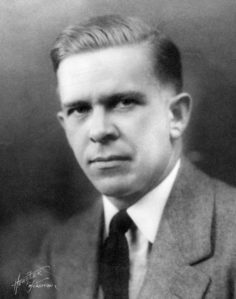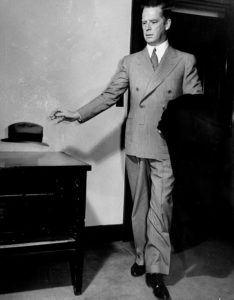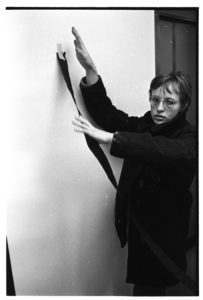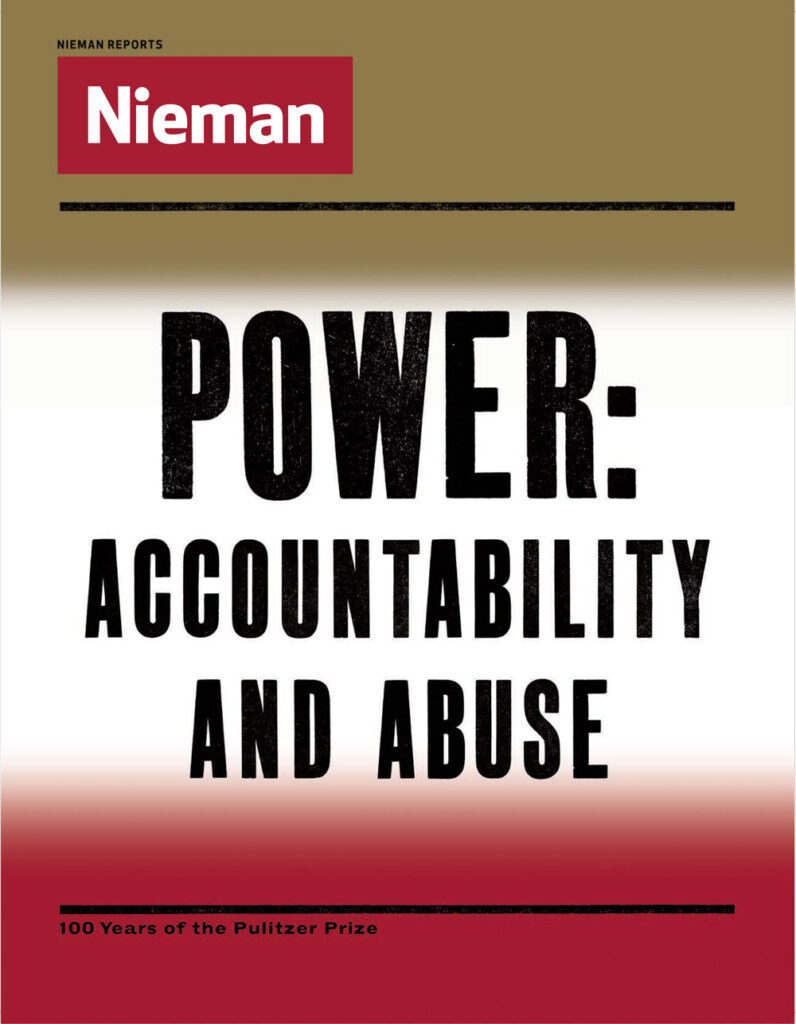From the start, the Pulitzer Prizes have sought to recognize journalists for investigating how power works, for holding the powerful to account, and for exposing abuses of power. Yet power itself ebbs and shifts, driven by cultural, political, and technological forces, and what galvanizes protest in one generation maybe overlooked in the next.
The early Pulitzers themselves were largely overlooked, in part because awards for anything, much less journalism, were uncommon a century ago. The Nobel Prizes had only been instituted in 1901. The Academy Awards wouldn’t start until 1929, the Tony Awards in 1947, the Grammys in 1959. It took years of evangelizing on the part of the board overseeing the Pulitzer Prizes to create widespread interest in the Pulitzers and the kind of journalism they honor.
The 10 stories that follow were all published 40 or more years ago. Many of them attracted national attention at the time, though they now have been superseded in the collective consciousness by stories like Watergate and Edward Snowden’s revelations about the National Security Agency’s surveillance program. The stories come from major papers and tiny ones, from deeply experienced journalists and neophytes. As the Pulitzers celebrate their centennial, these forgotten classics are reminders of the crucial watchdog role that journalists fulfill, a role as essential today as it was when these stories were written.
LINKS BETWEEN CRIMINALS AND GOVERNMENT OFFICIALS
Don R. Mellett
Canton (Ohio) Daily News
Public Service, 1927
“An infamous league existed between skulking crime and pious officialdom, a conspiracy so foul, cruel and cowardly that it did not hesitate to hire a wretched pawn to drive steel through the heart and brain of the one citizen who dared openly to challenge its power.” That’s how Editor & Publisher led its January 1, 1927 editorial about Patrick McDermott’s conviction for the murder of the editor of the Canton Daily News, Don R. Mellett, for exposing the links between crime and government.

Used by permission from McKinley Presidential Library and Museum, Canton, Ohio
Mellett’s series of stories on corruption, prisoner abuse, and the murder of alleged criminals got Canton police chief S.A. Lengel fired. (He was reinstated, only to be fired again during the investigation of Mellett’s murder.) Mellett also named criminal figures in town and the police officers he thought were under their influence. Mellett and his brother, city editor Lloyd Mellett, exposed how a local crime figure, Jumbo Crowley, used his influence to get an incompetent surgeon named chief of staff at a local hospital.
Don Mellett briefly employed a guard after he received threats over the paper’s stories. Shortly thereafter, Mellett was killed. McDermott was convicted of murder; a local police detective and another man received life sentences for their involvement in the murder plot. The police chief was also convicted of plotting the killing and jailed, but after multiple trials that conviction was overturned when two witnesses rescinded their testimony against him. The murder caused a national sensation in the press, which billed it as an attack on the First Amendment.
Journalists who investigate corruption outside the U.S. are more regularly in danger than those within the States; the most recent American journalist murdered for investigating corruption was in 2007, when Chauncey Bailey, editor of the Oakland Post, was looking into the fraudulent takeover of a local bakery. So far in 2016, 23 journalists have been killed in Syria, Mexico, Iraq and elsewhere, according to the Committee to Protect Journalists.
ABUSES IN A NEW JERSEY STATE PRISON
Harold Littledale
New York Evening Post
Reporting, 1918
Harold Littledale wasn’t the first journalist to go undercover and prompt reforms; the pioneering Nellie Bly had famously spent 10 days in an insane asylum in 1887. But Littledale spent months inside the Trenton, New Jersey prison he described as “medieval.” It’s unclear in what capacity he was there or how he observed what he did but what he hammered home in his stories was that prisoners warranted humane treatment.
Littledale’s narrative is unusual for an investigative story. Readers don’t meet an abused prisoner or his or her family members. Instead, Littledale uses simple declarative sentences: “It is hard to believe that the state’s wards are cast into dungeons,” he writes. “It is hard to believe that women are placed with men.” Then he shifts, beginning 45 sentences in a row with “It is a fact that …” He references the dungeons, where prisoners were chained to walls and given bread and water twice a day, the illegal overcrowding, the terrible food, and abusive labor practices, including depriving the working prisoners of the pittance they were supposed to be paid.
In closing, he invokes the 19th-century English prison reformer Elizabeth Fry and asks readers whether letting prisoners see sunlight or feeding the prisoners at tables rather than “having their food thrust into cages as if they were wild and dangerous beasts” amounts to “mollycoddling.” And he asks whether prison shouldn’t try to bring out the good in prisoners.
Littledale’s style may seem like editorializing to modern journalists, but it sparked immediate reform. Less than two weeks after his story appeared, the New Jersey legislature had empowered Governor Walter E. Edge to establish a Prison Inquiry Commission. The following month, the commission produced a report with nine recommendations, including bricking over the dungeons and giving prisoners access to open air during the day. It also acknowledged the near complete failure of the prison labor system.
Prison reform is again a hot story, in part because the U.S. has the largest number of prisoners of any country in the world. Practical concerns include overcrowding, safety, and excessive costs, as well as rates of recidivism that run as high as 77 percent. One note that might please Littledale: New Jersey was in the news late in 2015 for its success at reducing its population of prison inmates.
CORRUPTION IN AWARDING ACCESS TO OIL RESERVES
Paul Y. Anderson
St. Louis Post-Dispatch
Reporting, 1929

Oil companies have influenced American politics almost since the industry’s beginnings. For nearly as long, journalists have found them fruitful subjects for watchdog reporting. After all, it was Ida Tarbell’s pioneering muckraking on John D. Rockefeller’s Standard Oil Trust that led to the Supreme Court’s breakup of the trust into dozens of companies. About 20 years after Tarbell, it was reporting by the St. Louis Post-Dispatch journalist Paul Y. Anderson that was key to another scandal involving oil companies, this one the biggest federal corruption case until Watergate.
In what became known as the Teapot Dome scandal, oil companies paid bribes to government officials, notably Secretary of the Interior Albert B. Fall, in exchange for access—without competitive bidding—to the oil reserve near the Teapot Dome rock formation in Wyoming. The scandal, exposed in 1922, rocked President Harding’s administration and resulted in the appointment of a special prosecutor.
In 1924, Anderson, who had covered Teapot both as a freelancer and as a staff reporter at the Post-Dispatch, brought the story back to life. Because of his doggedness over unaccounted-for funds, the case was reopened on Capitol Hill. Anderson helped shape questions and testified at congressional hearings. It was this second round of hearings that put Fall and oil baron Harry Sinclair in jail. Pulitzer Prizes in 2015 that went to Bloomberg News for showing how companies dodged taxes and to The New York Times for chronicling how lobbyists skew the court system in favor of the wealthy continue Anderson’s venerable tradition of calling the powerful to account.
TIES BETWEEN ORGANIZED CRIME AND LABOR UNIONS
Westbrook Pegler
New York World-Telegram
Reporting, 1941
Westbrook Pegler’s Pulitzer for reporting was a unique distinction for a columnist. His winning columns uncovered scandals in the ranks of organized labor, leading to racketeering convictions. “Fair Enough”—Pegler’s six-day-a-week column on the front page of the New York World-Telegram—at one point was syndicated in 174 newspapers with 10 million readers.

In addition to unions and organized crime, Pegler’s targets included presidents (FDR was “moosejaw”), the New Deal, the Supreme Court, Congress, other journalists, and even his own publisher. The year before his Pulitzer win he exposed ties between organized labor and organized crime. He showed that William Bioff of the International Alliance of Theatrical Stage Employees and union head George Browne were in the pocket of the Chicago mafia. To wring millions of dollars out of Hollywood studios for the local mafia, the two threatened union strikes. They received reduced sentences in exchange for testimony against other mobsters.
The revelations kept coming. Pegler made public the fact that union president George Scalise had been convicted of white slavery in 1913. The union stood by him but months later an indictment accused Scalise of extorting more than $100,000 from New York employers. At trial, it was revealed that Scalise had long been a labor racketeer for Al Capone and the Chicago mob, siphoning union dues for the mob and himself. Scalise, who claimed he’d been “Peglerized,” received a 20-year sentence. For labor reporters, Pegler’s tactic in identifying even minor ties between union officials and organized crime was instrumental in press coverage of unions for decades to come. Now, with unions in decline, the focus turns to questionable practices by companies against non-unionized labor, like The New York Times’s Pulitzer-winning 2012 exploration of how Apple and other technology companies treat the workers who build their products.
PEONAGE IN FLORIDA
New York World
Public Service, 1924
It was the death by whipping of a 22-year-old white man, Martin Tabert, who had been leased to a turpentine manufacturer, that prompted The World’s crusading editor Herbert Bayard Swope to dispatch reporter Samuel McCoy to Florida. (Swope himself won the first Pulitzer Prize for Reporting in 1917, for his writings on the German Empire.) Peonage—forcing people to work off debts—was still widespread in the early part of the last century, and even when peons managed to take their cases to court, they usually lost. Tabert’s employer, Putnam Lumber, claimed that Tabert died of malaria, but Tabert’s Cabinmate wrote Tabert’s family in North Dakota with the true story. Tabert’s parents asked their county attorney to investigate, but he was stonewalled. A formal request for information by North Dakota’s legislature drew no answers but led to press coverage of the death. A grand jury indicted David Higginbotham, who had done the whipping.
McCoy’s reports on hearings about the case included a number of revelations. Higginbotham whipped workers for the fun of it. The local sheriff—paid $20 per worker by the lumber company—rounded up people for trivial offenses and when the poor couldn’t pay their fines, they were leased to the company. Higginbotham was indicted on a charge of first-degree murder and a number of company employees were fired. His conviction was overturned on a technicality by the Florida Supreme Court.
Peonage remained a staple of the railroad, lumber, and turpentine industries in Florida until about 1950. Most of the victims were black. And peonage remains an issue in Florida and elsewhere. The Coalition of Immokalee Workers says more than 1,200 people, mostly poor immigrants, were freed from modern slavery between 1997 and 2010. The problem remains huge outside the U.S., too, as evidenced by this year’s Pulitzer Prize for Public Service, given to The Associated Press for stories about the seafood industry in Southeast Asia, which resulted in the freeing of more than 2,000 slaves.
ASTUTE OBSERVATIONS AND ANALYSIS OF EUROPEAN AFFAIRS
Anne O’Hare McCormick
The New York Times
Correspondence, 1937

No individual or institution is more powerful than a national government, and journalists have a special fascination for the workings of the powers of the state. Anne O’Hare McCormick, the first woman to win a Pulitzer for journalism and the first to serve on the editorial board of The New York Times, was particularly gifted at explaining how states work and how leaders wield power. In the 1920s, she had anticipated the rise of Mussolini, writing “Italy is hearing the master’s voice.”
Her ability to see the broader diplomatic meaning in the seemingly personal was evident in an Easter dispatch from Paris, where churches were unusually packed. McCormick observed that France’s young people were rejecting their elders’ secularism and militarism. This was in “complete contrast,” she noted in one of the columns honored by the Pulitzer, to what was happening across the border in Germany, where that country’s re-absorption of the Rhineland was seen by the French as a clear violation of the 1925 Pact of Locarno. The British refusal to view it like that had sparked a crisis of confidence in France. McCormick correctly pegged the tension between the two countries as a sign that the collapse of the League of Nations and dark days for Europe were ahead.
It was obvious to McCormick that European nations could not solve their economic and political issues as individual entities. Their unique geopolitical and historical interdependence meant, as she wrote, “Europe’s problems are soluble only by an international intelligence.” McCormick’s words seem especially prescient today, as Europe is roiled by disagreements over how to handle refugee and debt crises and the U.K.’s vote to leave the European Union.
JOURNALISTS ON THE ILLINOIS STATE PAYROLL
George Thiem and Roy J. Harris
Chicago Daily News and St. Louis Post-Dispatch
Public Service, 1950
To deflect unwelcome questions and discourage investigative reporting, political, corporate, and other interests bring their power to bear on the press. And sometimes journalists give in. Perhaps the most egregious example of this took place among journalists at papers in southern Illinois who were on the “gravy train” of Illinois Governor Dwight H. Green from 1941 to 1949. These journalists took $480,000 (nearly $5 million in 2016 dollars) from the state and published editorials and stories promoting the governor’s agenda.
The story emerged via an unusual collaboration between two reporters who covered the Illinois State House. Roy J. Harris of the St. Louis Post-Dispatch had done a story about state expenses during the run-up to the 1948 election, which Green lost, and had noticed state records with what looked to him like journalists’ names. George Thiem of the Chicago Daily News had noticed that the Illinois state treasurer had issued a number of checks with the signature typed on. The two reporters discussed what each had found and decided to work together on the investigation. They spent more than two weeks reviewing payroll records county by county, comparing the 35,000 names on the payrolls to names from newspaper mastheads they had put on index cards.
In the end, they found 51 journalists at 32 Illinois papers who had what they called “gravy train” jobs, perhaps messenger clerk or field investigators, which sometimes paid them to do nothing. Thiem wrote that “newspapers are the most effective checks the citizens and taxpayers have on graft, payroll padding, incompetency, dishonesty and waste in public office. If the press fails them, God help our democracy.”
Their stories initially drew little interest from other newspapers, leading to a Washington Post editorial accusing papers of ignoring the bad deeds of journalists. It was a triumph of local investigative reporting into the misuse of power, both by members of the press and by politicians. It remains a cautionary tale for journalists. The scandal prompted calls for ethics reforms by a number of newspapers, and notably by the head of the CIO American Newspaper Guild, a powerful union at the time.
Celebrating 100 Years of Excellence in Journalism and the Arts
Join us at Harvard’s Sanders Theatre on Sept. 10-11 as we celebrate 100 years of the Pulitzer Prize and explore the theme “Power: Accountability and Abuse” with two dozen Pulitzer winners. Visit the Nieman Foundation’s Pulitzer Centennial event page to learn more.
ABUSES IN A FACILITY FOR THE CRIMINALLY INSANE
Acel Moore and Wendell Rawls Jr.
The Philadelphia Inquirer
Local Investigative Specialized Reporting, 1977
Among the most vulnerable members of society are those with serious mental illnesses. Their conditions can make it hard for others to believe their stories. Yet it was with the help of such a source that The Philadelphia Inquirer documented a culture of abuse at Pennsylvania’s Farview State Hospital, then a maximum-security facility for the criminally insane.

Former patients claimed that they had witnessed the murder of a patient at the hospital 10 years earlier. The county coroner exhumed the body, and the story was assigned to Acel Moore. Having spent years writing obituaries, Moore recognized the name of the dead man: Robert “Stonewall” Jackson. The official story was that Jackson died of a heart attack at age 36. But former patients said he had been smothered with a pillow while bound to a bed in the infirmary, where he was recovering from a beating he’d endured at the hands of staff. In response to a story Moore wrote about Jackson, a former patient told him about other beatings and murders he’d witnessed.
Moore convinced his editors that a tip from a former mental patient was worth checking out. He and fellow reporter Wendell Rawls Jr. spent three months talking to former patients, guards, state officials, and other sources, and gathering documents about the hospital’s treatment of patients. In June of 1976 they published the first of a series of stories, using repetition to make their point:
“Farview State Hospital is a place where men have died during or after beatings by guards and by patients egged on by guards.
It is a place where men who have died this way have been certified as victims of heart attacks.
It is a place where men have been pummeled bloody and senseless—for sport.”
After their series ran, a grand jury indicted 36 people, 58 patients were transferred out of the hospital, and the federal government eliminated a $600,000 annual subsidy to the hospital. But as in the Florida peonage scandals, local juries did not convict their neighbors and other people who worked at a major local employer. Only one guard was convicted, of assault.
This year, the Pulitzer for Investigative Reporting went to the Tampa Bay Times and the Sarasota Herald-Tribune for exposing neglect and abuse at Florida mental hospitals; the Pulitzer for Editorial Writing went to the Sun Newspapers for calling out Florida corrections officials after guards killed an inmate.
A MURDEROUS POLITICAL MACHINE
Caro Brown
Alice (Texas) Daily Echo
Local Reporting – Edition time, 1955
Journalists from Lincoln Steffens to John Gunther have assailed political machines, but even critics acknowledge that such operations can be effective at building infrastructure and enfranchising citizens. One of the legendary political machines of the 20th century was that built by the Parr family in rural south Texas. George Parr’s name pops up in history for the role he played in Lyndon B. Johnson’s political fortunes. In 1948, when it appeared that Johnson had lost his U.S. Senate Democratic primary race against Coke Stevenson, a former governor of Texas, Parr brought forth what he said was an uncounted ballot box and other rural counties revised their final vote counts, as documented by Robert A. Caro in the second volume of his LBJ biography “The Years of Lyndon Johnson.” Johnson was victorious as well in the general election.

Courtesy of Corpus Christi Caller-Times
Parr’s machine developed a penchant for murder. Sam Southwick, a sheriff’s deputy who was part of Parr’s machine, killed journalist W.H. Mason for reporting that Southwick benefited from a gambling and prostitution establishment. Mason, formerly editor of the Alice Daily Echo, had previously been beaten by the sheriff for similar reporting. Meanwhile, another deputy killed the son of a Parr political rival. That second shooting drew state and federal investigators to Duval County.
Having started at the 5,291-circulation paper as a proofreader three years earlier, Caro Brown was the sole reporter covering the Parr story on a daily basis. One time when guns were drawn she stepped between Parr and a Texas Ranger to defuse a confrontation. The Texas attorney general lauded her bravery in the face of threats of violence against her and her daughter. Another state official gave her a pistol with instructions on how to use it.
Any reporter investigating abuses of power faces significant challenges, but doing so in a small town is particularly intense. And at a time when female reporters were rare, Brown faced resentment from men in her own newsroom. It got so bad that she left journalism a week after winning the Pulitzer. Parr didn’t face justice until decades later. In 1975, after Parr was convicted of income tax evasion, he committed suicide, rather than go to prison.
PROFILE OF AN AMERICAN TERRORIST
Lucinda Franks and Thomas Powers
United Press International
National Reporting, 1971
In the 21st century, in the wake of the 9/11 attacks, Americans have mostly looked outside U.S. borders for terrorists. But in the 1960s and 1970s, as grassroots movements pushed against political and military power, the conditions were conducive to homegrown terrorists.

Michigan Daily Alumni Photographers. Jay Cassidy. Bentley Historical Library, University of Michigan
Lucinda Franks and Thomas Powers documented how Diana Oughton became a member of the radical group the Weather Underground and died at age 28 when a bomb she may have been working on blew up in a Greenwich Village townhouse. Their five-part series examined how Oughton’s work in poor parts of Philadelphia and Guatemala left her disillusioned with U.S. domestic and foreign policy and how she turned against her family, convinced that radical action was required to force those in power to surrender it.
Franks, like Oughton, had grown up in a wealthy family. Each attended one of the exclusive all-female Seven Sisters colleges (Oughton attended Bryn Mawr, Franks Vassar). Franks also had sharp disagreements with U.S. social and foreign policy. Her similarity to Oughton helped convince the Oughton family to talk to her; Oughton’s father asked her to explain his daughter to him. And Franks’ youth—she was 23 at the time—helped radicals trust her enough to bring her to some of their havens and tell her their side of the story. Her nuanced story showed how white radicals were driven to outdo their parents by standing in solidarity with people who lacked power and money.
There are echoes today of the political ferment of the ’60s and ’70s. Protest movements such as Black Lives Matter hew closer to the nonviolence espoused by the Rev. Martin Luther King Jr. than to the rhetoric of the Weather Underground or the Black Panthers, but the Panthers began as citizen patrols monitoring police brutality, and the Weathermen’s roots were nonviolent. Radicalization emerged only after debate, dissension, and a sense of not being heard.




